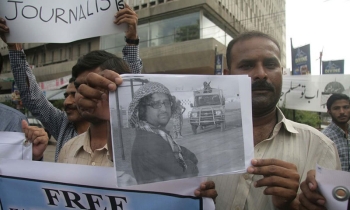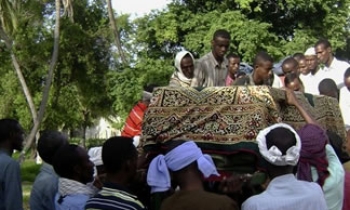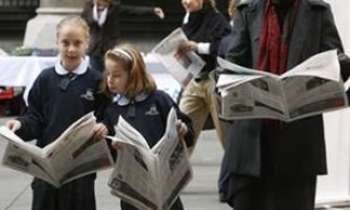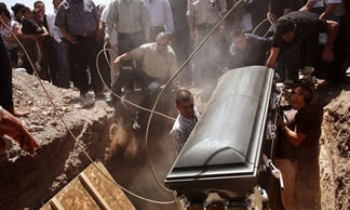Journalism – unlike literature, theater, art, music, film, or situation comedy – has never had much of a canon, a reasonably well-accepted collection of great works. This is lamentable. It leaves us, as we read the latest dispatch from Washington or a war zone, without models that might help us understand what such a dispatch might be. It allows us to mistake an interesting feature in the Times this week or some particularly persuasive piece of reporting in the current New Yorker for the best that journalism has to offer.
The absence of an established canon also deprives journalism of much of the nobility it might have. Couldn't a reminder that large talents once wielded our pens and tapped on our keyboards provide some consolation as we face the latest wave of criticism? Perhaps we have lost ourselves once again in some unedifying scandal; perhaps another young reporter has taken leave of the facts; but this is also the profession that stationed an Edward R. Murrow in London, that imbedded a Tom Wolfe with the hippies.
There is one benefit, however, to the absence of any widely accepted notion of what are the greatest works of journalism: it means that any of us with some time to spend in the library can piece together our own lists. My colleagues and I have had a go at this. For many years now, all graduate students in journalism at New York University have been inspired by some version of the collection we have assembled. And a few years ago – together with a panel of distinguished, library-going journalists – we selected "the top hundred works of journalism in the United States in the twentieth century." Neither exercise, alas, however meritorious or well-publicized, has done much to alter the situation: journalism still doesn't have much of a canon.
Which means that Jon E. Lewis, a British writer and historian, is free to take a shot at coming up with one. That Lewis has settled upon a hundred and one articles is not a gimmick I am in a position to question. That his publisher bills the works in this collection as "masterpieces" – "greatest newspaper articles," in the British edition – in a book that is the forty-fifth in the Mammoth Book of series, following not only The Mammoth Book of Arthurian Legends but The Mammoth Book of UFOs, is certainly not auspicious.
Nonetheless, much fine writing and reporting is enshrined in this book. Lewis reprints, to begin with, some classics (by which I mean writings with which I am familiar): Grantland Rice's inflation of four Notre Dame football players to apocalyptic proportions ("In dramatic lore they are known as Famine, Pestilence, Destruction and Death. These are only aliases. Their real names are Stuhldreher, Miller, Crowley and Layden"); Murrow's celebration of the humble courage of the people of London during the blitz (The humble courage of the English is a theme that recurs in this volume); Ernie Pyle's graceful tiptoe along the line between maudlin and deeply moving in "The Death of Captain Waskow"; Seymour Hersh's lonely exposure of the My Lai massacre; selections from Tom Wolfe's kinetic and revelatory Electric Kool-Aid Acid Test, and John Hersey's stunning account of the destruction of Hiroshima, first printed in The New Yorker. (All of the above were on our top-hundred list, with Hersey's work ranked first.)
Charles Dickens, Mark Twain, Stephen Crane, Jack London, John Steinbeck, Ernest Hemingway, George Orwell, and Norman Mailer are also represented here. So are writers, such as William Howard Russell and Richard Harding Davis, who may have been just about as well known in their time but whose reputations have faded because they were earned in (canon-less) journalism more than in (canon-heavy) fiction.
Lewis also comes up with some surprises (to me, it being rather easy to surprise me with the work of British journalists): a young fellow by the name of Winston Churchill, for example, reporting for the Morning Post from South Africa in 1900, during the Boer War: "I do not fight. But swords are not the only weapons in the world. Something may be done with a pen." And Lewis includes a glimpse of the destruction of a city – and a lesson in the power of a conjunction – penned by Archibald Forbes, a reporter for London's Daily News. Forbes (one of a number of his contributors about whom our editor tells us nothing) is writing about the suppression of the Paris Commune in 1871:
"Paris the beautiful" is Paris the ghastly, Paris the battered, Paris the burning, Paris the blood-splattered, now. And this is the nineteenth century, and Europe professes civilization, and France boasts of culture, and Frenchmen are braining one another with the butt ends of muskets, and Paris is burning.
Lewis's collection is not, however, without its holes. (Some of the fine pieces he has included, I should acknowledge, make me realize that the collections I have helped put together have also had some holes.) To begin with – and in the grand tradition of canons – Lewis celebrates mostly the work of white males. Based on my analysis of first names, seven women are honored with bylines here, including Dorothy Parker (arguing for Hemingway's short stories over his novels), Martha Gellhorn (observing, with horrifying impotence, a lynching), and Gloria Steinem ("I Was a Playboy Bunny"). Lewis might have looked more closely at the work of, among others, Margaret Fuller, Dorothy Thompson, the British travel writer Freya Stark, Joan Didion, and Rachel Carson. (Carson's Silent Spring was ranked second on our top hundred list.) I also failed to recognize the names of any African-American writers in his table of contents. (I don't know how many British journalists of color are included.) Frederick Douglass, Ida B. Wells, and James Baldwin certainly deserve to be there.
This collection – however mammoth – also seems to start rather late (with Dickens in 1845). And it is not always clear that Lewis has ferreted out the best work of the writers he does include. The two Dickens pieces he reproduces here are good; "On Duty with Inspector Field," which Lewis does not include, may be better. An excerpt:
How many people may there be in London, who, if we had brought them deviously and blindfolded, to this street, fifty paces from the Station House, and within call of St. Giles's church, would know it for a not remote part of the city in which their lives are passed? How many may there be, that could look round on the faces which now hem us in . . . – the lowering foreheads, the sallow cheeks, the brutal eyes, the matted hair, the infected, vermin-haunted heaps of rags – and say "I have thought of this. I have not dismissed the thing. I have neither blustered it away, nor frozen it away, nor tied it up and put it away, nor smoothly said pooh, pooh! to it, when it has been shown to me"?
Lewis, perhaps more egregiously, calls on Hemingway merely for what seems a Spanish Civil War roundup, instead of allowing him to demonstrate his knack for haunting detail. This, on that same conflict but not in this collection, is from "A New Kind of War"
A policeman covers the top of the trunk, from which the head is missing; they send for someone to repair the gas main and you go in to breakfast. A charwoman, her eyes red, is scrubbing the blood off the marble floor of the corridor. The dead man wasn't you nor anyone you know and everyone is very hungry in the morning after a cold night and a long day the day before up at the Guadalajara front.
One of the reasons work in this field has failed to gel into a canon is that it is difficult to figure out what exactly to canonize. Are we celebrating stories about major events? Lewis often does. Thus we get a bit of Merriman Smith's not particularly distinguished recollection of covering the Kennedy assassination for United Press International, coverage for which he did win a Pulitzer Prize. (Among Smith's more memorable accomplishments that day was the football move, not discussed here, with which he prevented the Associated Press reporter from getting to the car phone.) And, perhaps inevitably, we are given a Daily Telegraph account of England's World Cup triumph in 1966, complete with a listing of players and referees.
Most major wars also get a shout in Lewis's collection, as do a series of catastrophes. He professes, in his short introduction, to be interested in "the eyewitness capture and compression in words of events." He is interested, in other words, in journalism as history – or journalism as an up-close, open-eyed, if sometimes ragged and unreflective, "first draft of history" (a phrase Lewis uses). They were there, so you have a chance to be, in a sense, there – a privilege, no doubt. But this approach seems more a celebration of journalism's existence – of the fact that someone with some descriptive talent has usually managed to be on the scene – than of its possibilities.
Another standard that might be used in putting together such a collection is the historical significance of the journalism itself. This is not Lewis's strong point. Henry Morton Stanley's account, in the New York Herald, of finding the missing missionary Dr. David Livingstone deep in Africa does not appear here, nor does the editorial writer Francis Church's lyrical response in the New York Sun to eight-year-old Virginia's question about the existence of Santa Claus:
Virginia, your little friends are wrong. They have been affected by the skepticism of a skeptical age. They do not believe except they see. They think that nothing can be which is not comprehensible by their little minds. All minds, Virginia, whether they be men's or children's, are little.
The journalism that actually nudged the world along is also not that well represented in this collection – for example, Horace Greeley's "The Prayer of Twenty Millions," which may have helped inspire Lincoln to free the slaves. Perhaps most shamefully, he does not include Thomas Paine's pamphlet, Common Sense, which spread across the colonies like, as one newspaper at the time put it, "a ray of revelation." (Surely Lewis understands that journalism can bring revelation through its deployment of analysis and opinion as well as its deployment of fact; in his introduction he makes clear that while his book mostly features "reportage," it also includes "the occasional piece of humor, opinion and journalist's memoir.")
The Mammoth Book of Journalism divides itself fairly evenly between British and American journalism (with a piece or two from Australia and South Africa thrown in). But Lincoln Steffens and his fellow American muckrakers are not here. And the book does not include anything from Bob Woodward and Carl Bernstein's Watergate investigation, although their work is mentioned in its introduction.
William Howard Russell's reporting for the Times of London on the poorly run British campaign in the Crimea was indeed historically significant, as Lewis notes, because Russell's criticism of the military led to important reforms. His article, included in this book, on the battle of Balaclava has an added significance: Alfred Tennyson read it.
A comparison of Russell's and Tennyson's accounts of the hopeless and, consequently, achingly courageous charge of the Light Brigade at Balaclava raises what is perhaps the most important question about the possibility of a journalistic canon:
Russell: "They advanced in two lines, quickening their pace as they closed towards the enemy. A more fearful spectacle was never witnessed than by those who, without the power to aid, beheld their heroic countrymen rushing to the arms of death."
Tennyson: "Into the valley of death/rode the six hundred."
Russell: "Their desperate valor knew no bounds, and far indeed was it removed from its so-called better part – discretion."
Tennyson: "Theirs not to make reply,/Theirs not to reason why,/Theirs but to do and die."
The question (if you agree with me that the poet gets somewhat the best of this comparison): Is journalism – for all its speed and freshness, its witness to history, its contributions to history – really good enough to command a canon? Didn't Dickens and Hemingway – to approach the question from a different direction – do their best writing in another genre? The answer – the ultimate justification for celebrating the great works of journalism – has to be found, of course, in the anointed works themselves. They must stand, in the end, as something much more than mere "first drafts."
The observations they contain must have – and retain – an extraordinary power. This dispatch from a war zone was written for the New York Tribune in 1914 by Richard Harding Davis. It is from Lewis's collection:
The entrance of the German army into Brussels has lost the human quality. It was lost as soon as the three soldiers who led the army bicycled into the Boulevard du Regent and asked the way to the Gare du Nord. When they passed the human note passed with them.
What came after them, and twenty-four hours later is still coming, is not men marching, but a force of nature like a tidal wave, an avalanche or a river flooding its banks. At this moment it is rolling through Brussels as the swollen waters of the Concemaugh Valley swept through Johnstown.
The analysis these works of journalism display must be especially, if not astonishingly, compelling. The following lines, not included in this book, are from James Baldwin's account, published in the Partisan Review in 1959, of his first visit to an American South battling over school integration:
I saw the Negro schools in Charlotte, saw, on street corners, several of their alumnae, and read about others who had been sentenced to the chain gang. This solved the mystery of just what made Negro parents send their children out to face mobs.
The writing must carry exceptional force. These edifying sentences, also left out of Lewis's collection, were occasioned by a murder in Southern California. They were written for a magazine in 1966 by Joan Didion (at her most scathing):
This is the country in which a belief in the literal interpretation of Genesis has slipped imperceptibly into a belief in the literal interpretation of Double Indemnity . . . . "We were just crazy kids," they say without regret, and look to the future. The future always looks good in the golden land, because no one remembers the past . . . . Here is the last stop for all those who come from somewhere else, for all those who drifted away from the cold and the past and the old ways. Here is where they are trying to find a new life style, trying to find it in the only places they know to look: the movies and the newspapers.
Establishing a canon is hardly a simple business. We can debate, we must debate, what qualifies a work as great. That is part of the purpose. And canons are made to be challenged, reevaluated – endlessly. That is part of the fun. But surely in writings such as these – some included in Lewis's book, some not – there are the makings of a canon.









